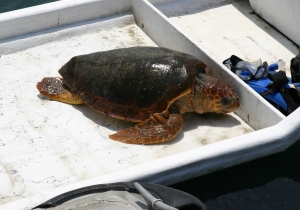Grant: 05-032R
Project Title: Establishing Plasma Biochemical and Hematocrit Reference Intervals for Sea Turtles in Florida
Project Manager: Dr. Elliott Jacobson
Organization: University of Florida - College of Veterinary Medicine (Research and Educational Institute)
Grant Amount: $11,671.00
Completion Date: 2009-09-17
Summary: For the second year of this project, we will continue to address the need of an integrated health assessment program with one of our objectives being to develop optimum methods for the collection, transport, and biochemical analysis of plasma. Over the last 3 years we have been working toward this goal. Given the paucity of information on normal reference intervals for plasma biochemicals of sea turtles, we are now in a position to develop this database. Based on many years of combined experience, we believe that sea turtles caught in the canal system of Port St Lucie Plant, Jensen Beach, Florida, afford us a unique opportunity to build a database that could be used for assessing health of sea turtles throughout the state of Florida and elsewhere in the world. Multiple interactions can be studied including size (age), sex, season, and water temperature on blood biochemical profiles. While green and loggerhead sea turtles are the most common species caught in the canal system, there also is an opportunity to develop a database on plasma biochemicals of hawksbill, Atlantic ridley and leatherback sea turtles. Injured and ill turtles are also trapped and these turtles can followed until their release from rehabilitation facilities. As part of this study, a webpage will be constructed where findings will be continually updated as they become available. In this way, plasma biochemical reference intervals will be available to the worldwide community of sea turtle biologists, sea turtle rehabilitators and veterinarians working on health problems of sea turtles.  Results: We have all samples requested (415) for completion of this project. All hematocrit, plasma biochemical, and protein fraction concentrations results are posted on a webpage (http://accstr.ufl.edu/blood_chem.htm) that is available online. An instructional DVD showing "how to bleed a sea turtle" is linked to this webpage. A CD of images of sea turtles removed from the intake canal at St. Lucie Power Plant is included. The following paper was submitted for publication to the Journal of the American Veterinary Medical Association: Osborne AG, Jacobson ER, Bresette M, Singewald D, Scarpino R, Bolten AB. 2009. Reference Intervals and relationships between health status, carapace length, body mass, and water temperature, and concentrations of plasma protein and protein fractions of the Atlantic loggerhead sea turtle (Caretta caretta) and the green turtle (Chelonia mydas). J Amer Vet Med Assoc. This paper was returned to us, revided, and resubmitted. We expect it will be accepted. Data collected on concentrations of plasma proteins and protein electrophoretogram fractions became the focus of another veterinary student's (Ann Osborne) research project that was completed and is being developed into a paper for submission to the Journal of the American Veterinary Medical Association. We expect several additional papers to be outcomes of this project. (Author: Dr. Elliott Jacobson)
Results: We have all samples requested (415) for completion of this project. All hematocrit, plasma biochemical, and protein fraction concentrations results are posted on a webpage (http://accstr.ufl.edu/blood_chem.htm) that is available online. An instructional DVD showing "how to bleed a sea turtle" is linked to this webpage. A CD of images of sea turtles removed from the intake canal at St. Lucie Power Plant is included. The following paper was submitted for publication to the Journal of the American Veterinary Medical Association: Osborne AG, Jacobson ER, Bresette M, Singewald D, Scarpino R, Bolten AB. 2009. Reference Intervals and relationships between health status, carapace length, body mass, and water temperature, and concentrations of plasma protein and protein fractions of the Atlantic loggerhead sea turtle (Caretta caretta) and the green turtle (Chelonia mydas). J Amer Vet Med Assoc. This paper was returned to us, revided, and resubmitted. We expect it will be accepted. Data collected on concentrations of plasma proteins and protein electrophoretogram fractions became the focus of another veterinary student's (Ann Osborne) research project that was completed and is being developed into a paper for submission to the Journal of the American Veterinary Medical Association. We expect several additional papers to be outcomes of this project. (Author: Dr. Elliott Jacobson)